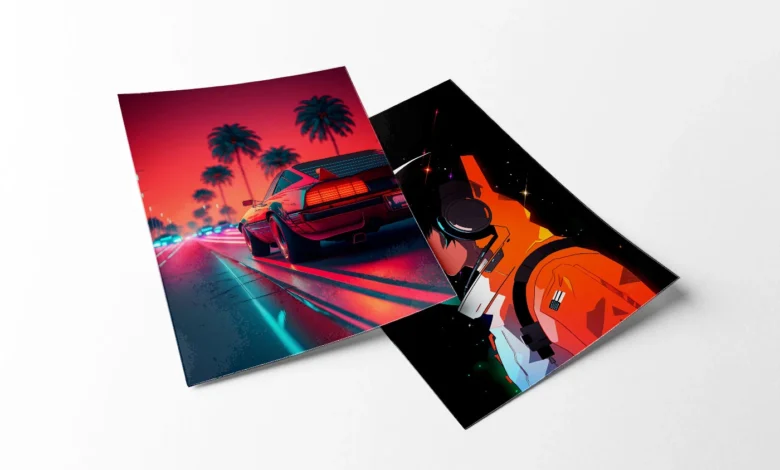Custom Posters: How to Create and Design Unique Posters

In today’s fast-paced digital world, custom posters remain an essential tool for businesses, events, and personal projects. Whether you’re promoting a product, event, or personal brand, a well-designed custom poster can capture attention, engage audiences, and drive results. Designing unique posters that stand out requires creativity, strategy, and the right tools. This comprehensive guide will show you how to design custom posters that not only look stunning but also serve their intended purpose effectively.
What Are Custom Posters?
Custom posters are personalized designs created for specific purposes, ranging from marketing to decoration. These posters allow individuals and businesses to convey messages through eye-catching visuals, fonts, and color schemes tailored to their specific needs. Whether it’s for advertising, branding, or artistic expression, custom posters offer flexibility in terms of style, content, and layout.
Why Custom Posters Matter for Your Brand
In a crowded marketplace, standing out can be a challenge. Custom posters give you the opportunity to convey your brand’s personality and message in a way that resonates with your target audience. Unlike generic posters, custom-designed posters allow you to craft unique and memorable experiences for viewers, whether they’re potential customers, event-goers, or just passing by.
When done right, custom posters can:
- Boost brand awareness: Eye-catching visuals grab attention.
- Increase engagement: Well-designed posters encourage action, whether it’s attending an event or visiting your website.
- Strengthen brand identity: Customized designs reflect your brand’s uniqueness.
Step-by-Step Guide to Designing Custom Posters
1. Define Your Purpose and Audience
Before jumping into the design, it’s crucial to understand the purpose of your poster and who your target audience is. Whether you’re promoting an event, product, or service, knowing the goal will help shape your design. Is your audience young professionals, students, or families? Defining this will influence your choice of images, fonts, and colors.
2. Select the Right Size and Format
Choosing the right size for your custom poster depends on where it will be displayed. Common poster sizes include:
- 11” x 17”: Ideal for small-scale promotions or personal use.
- 18” x 24”: Suitable for storefront windows or event promotions.
- 24” x 36”: Perfect for large-scale advertising or conferences.
Ensure that the resolution of your design is high enough for printing at the chosen size to avoid pixelation or poor-quality prints.
3. Craft a Strong Visual Hierarchy
When designing custom posters, establishing a clear visual hierarchy is essential for guiding the viewer’s eye and making the poster easy to read. This can be achieved through:
- Bold headlines: Use larger, bolder fonts for the main message.
- Subheadings and body text: These should be smaller but still legible.
- Contrasting colors: Highlight important information with contrasting colors to draw attention.
For example, use bold fonts and colors like red or yellow to emphasize your main message while keeping the background neutral.
4. Use High-Quality Images and Graphics
Visuals play a critical role in any custom poster design. Opt for high-resolution images and vector graphics that don’t lose quality when enlarged. Whether it’s a photograph, illustration, or logo, make sure it aligns with your overall theme and complements the text rather than overpowering it.
Free resources like Unsplash and Pexels provide access to high-quality, royalty-free images that can be used in your design. If you have a brand logo or specific images, ensure they’re professionally formatted for optimal quality.
5. Choose Fonts and Typography Wisely
Typography is more than just a design element; it’s a way to communicate your message. When designing custom posters, the fonts you choose should be:
- Readable: Ensure that your text is legible from a distance.
- Appropriate for the theme: Choose fonts that align with the poster’s purpose. For example, a professional seminar might use serif fonts, while a concert poster might use bold sans-serif fonts.
Use a maximum of two or three fonts to maintain a clean and cohesive design. Pairing contrasting fonts, such as bold headers with more delicate body text, can help create balance and clarity.
6. Focus on Color Schemes
Color is a powerful tool in poster design, helping to evoke emotions and direct attention. Your color scheme should align with your branding and the message you’re trying to convey. For instance:
- Bright, warm colors (red, orange, yellow) create energy and excitement.
- Cool tones (blue, green, purple) evoke calmness and professionalism.
- Black and white with pops of color create a sleek and modern look.
Using a consistent color palette ensures that your custom posters are visually appealing and easily recognizable.
7. Incorporate White Space
Don’t feel the need to fill every inch of your custom poster with text or images. White space, or negative space, helps balance the design and ensures that your key message stands out. A cluttered design can overwhelm the viewer and dilute your message.
8. Add a Clear Call-to-Action (CTA)
Whether you want people to visit your website, attend an event, or purchase a product, every custom poster should include a clear call-to-action. Your CTA should be bold and easy to locate on the poster, whether it’s a phone number, website, or social media handle.
9. Test and Review Your Design
Before finalizing your custom poster, take the time to review it carefully. Ensure that:
- All text is legible: Check for readability from different distances.
- Spelling and grammar are correct: Mistakes can damage your credibility.
- The design aligns with your brand: Consistency is key to maintaining brand identity.
Where to Use Custom Posters
Custom posters can be used in various contexts, depending on your goals and audience. Some common uses include:
- Business promotions: Launching a new product or service.
- Event advertising: Promoting concerts, conferences, or community events.
- Personal projects: Custom posters for home decor or gifting.
- Artistic expression: Creative posters showcasing artwork or photography.
How to Print Your Custom Posters
Once your custom poster design is complete, printing is the next important step. To ensure the best results:
- Choose a professional printing service: Local print shops or online platforms like Vistaprint offer high-quality prints in various sizes and materials.
- Select the right paper stock: For a premium finish, consider thicker, glossy paper stock that enhances the colors and details of your design.
- Check proofs before printing: Always request a proof to check for any last-minute adjustments before printing in bulk.
Conclusion: Create Custom Posters That Stand Out
Designing custom posters that capture attention requires a thoughtful blend of creativity and strategy. By defining your purpose, selecting the right visuals, and crafting a clear call-to-action, your posters can become powerful tools for communication and branding. Whether you’re promoting an event or simply expressing your creativity, following these steps will help you create posters that leave a lasting impression.





